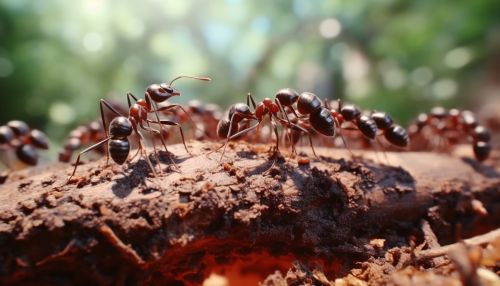Kin Selection Theory
Overview
Kin selection theory is a fundamental concept in evolutionary biology, which explains how altruistic behavior can evolve. The theory was first proposed by British evolutionary biologist W.D. Hamilton in 1964. The theory posits that an organism will act in ways that ensure the survival of its own genes, either by promoting its own survival or that of its kin. This behavior is often seen in social insects, such as bees, ants, and wasps, where sterile workers sacrifice their own reproductive potential to aid the reproduction of their relatives.
Concept
The concept of kin selection is based on the principle of inclusive fitness, which considers not only the individual's own offspring but also the offspring of its relatives. The theory suggests that the cost of an individual's altruistic act is compensated by the benefit to its relatives, weighted by the coefficient of relatedness. This coefficient measures the probability that a gene in an individual is also present in its relative due to common descent. The theory is encapsulated in Hamilton's rule, which states that an altruistic act will be favored by natural selection if the cost to the altruist is less than the benefit to the recipient multiplied by their degree of relatedness.
Mathematical Representation
Hamilton's rule is mathematically represented as rB > C, where r is the coefficient of relatedness, B is the benefit to the recipient, and C is the cost to the altruist. The coefficient of relatedness, r, is a measure of genetic similarity. For example, full siblings share 50% of their genes, so r = 0.5. If the benefit to the recipient and the cost to the altruist are both measured in terms of offspring produced, then an altruistic act is favored by natural selection if it results in more than twice as many additional offspring for the recipient as it costs the altruist.
Evidence
Empirical evidence for kin selection theory comes from various species across the animal kingdom. For example, in the social insects, sterile workers often help their mother, the queen, to produce more offspring. This behavior can be explained by kin selection, as the workers share 50% of their genes with their mother and 75% with their sisters due to the haplodiploid sex-determination system in these insects. Other examples include alarm calling in ground squirrels, where individuals risk their own safety to warn relatives of approaching predators, and cooperative breeding in birds, where non-breeding individuals help to raise the offspring of their relatives.
Criticisms and Controversies
Despite its wide acceptance, kin selection theory has faced criticisms and controversies. Some critics argue that group selection, rather than kin selection, is a better explanation for the evolution of altruism. Others question the validity of the assumptions underlying Hamilton's rule. The theory has also been challenged by the discovery of phenomena such as genomic imprinting and intra-genomic conflict, which suggest that genes can have different effects depending on their parental origin. However, proponents of kin selection argue that these phenomena can be incorporated into the framework of kin selection and inclusive fitness.
Implications
Kin selection theory has profound implications for our understanding of social behavior and the evolution of cooperation. It provides a framework for predicting when and why individuals will help their relatives, and it has been used to explain a wide range of behaviors, from altruism in social insects to human nepotism. The theory also has potential applications in conservation biology, as it predicts that kin selection could be used to promote cooperative behavior in endangered species.
See Also


